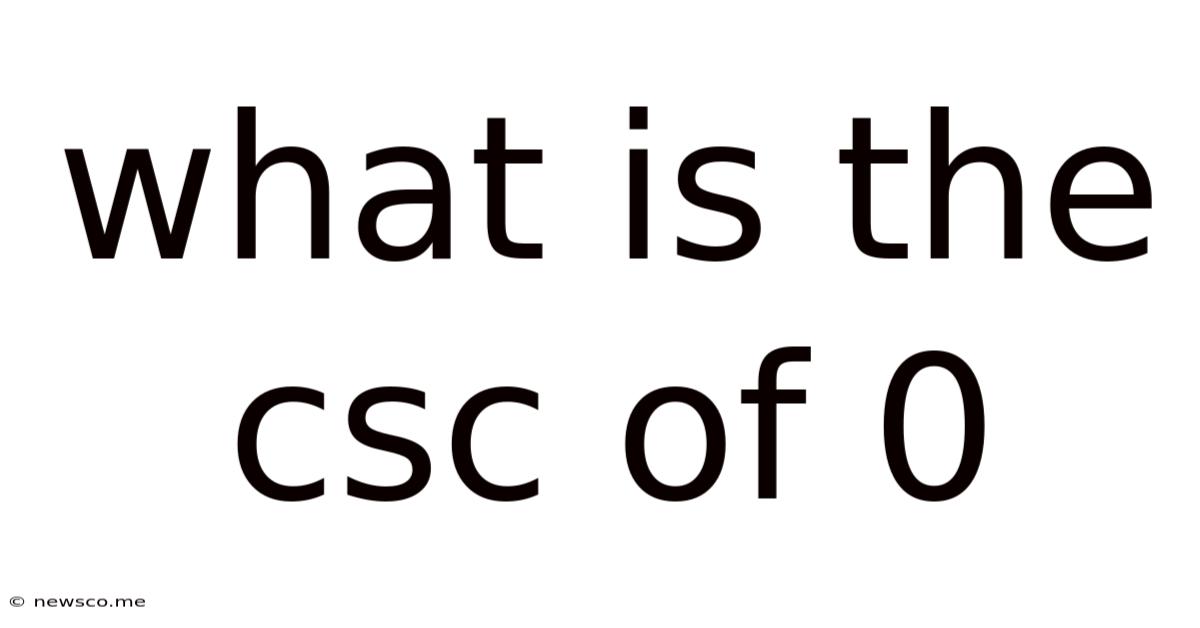What Is The Csc Of 0
News Co
May 08, 2025 · 5 min read

Table of Contents
What is the CSC of 0? Understanding the Cosecant Function and its Behavior at Zero
The question "What is the CSC of 0?" refers to finding the cosecant of 0, a fundamental trigonometric function. Understanding this requires a grasp of the cosecant function's definition, its relationship to the sine function, and the behavior of trigonometric functions at specific points. This article will delve into these concepts, exploring the mathematical reasoning behind the answer and providing a comprehensive understanding of the cosecant function.
Understanding the Cosecant Function
The cosecant (csc) is one of the six main trigonometric functions. It's the reciprocal of the sine function (sin). In simpler terms:
csc(x) = 1 / sin(x)
This means that the cosecant of an angle x is equal to the reciprocal of the sine of that angle. Since the sine function represents the ratio of the opposite side to the hypotenuse in a right-angled triangle, the cosecant represents the ratio of the hypotenuse to the opposite side.
Domain and Range of the Cosecant Function
It's crucial to understand the domain and range of the cosecant function to comprehend its behavior at different points, including 0.
-
Domain: The cosecant function is undefined wherever the sine function is equal to zero. This occurs at integer multiples of π (πn, where n is an integer). Therefore, the domain of csc(x) is all real numbers except multiples of π.
-
Range: The range of the cosecant function is all real numbers greater than or equal to 1 or less than or equal to -1. This is because the sine function is bounded between -1 and 1, and its reciprocal will always be outside the interval (-1,1). In interval notation, the range is (-∞, -1] ∪ [1, ∞).
Evaluating csc(0): The Limit Approach
Directly substituting 0 into the formula csc(x) = 1/sin(x) leads to division by zero, which is undefined in mathematics. To determine the behavior of the cosecant function as x approaches 0, we need to use the concept of limits.
Limits and Continuity
A limit describes the value a function approaches as its input approaches a particular value. In this case, we're interested in the limit of csc(x) as x approaches 0:
lim (x→0) csc(x)
Since csc(x) = 1/sin(x), we can rewrite this as:
lim (x→0) (1/sin(x))
As x approaches 0, sin(x) approaches 0 as well. This means we have a limit of the form 1/0. The limit will either approach positive infinity, negative infinity, or be undefined, depending on the direction of approach.
Analyzing the Left and Right-Hand Limits
To better understand the behavior, let's examine the left-hand limit (x approaching 0 from the negative side) and the right-hand limit (x approaching 0 from the positive side).
-
Left-hand limit (x → 0⁻): As x approaches 0 from the left (negative values), sin(x) approaches 0 through negative values. Therefore, 1/sin(x) approaches negative infinity.
-
Right-hand limit (x → 0⁺): As x approaches 0 from the right (positive values), sin(x) approaches 0 through positive values. Therefore, 1/sin(x) approaches positive infinity.
Since the left-hand limit and the right-hand limit are different (negative infinity and positive infinity, respectively), the limit of csc(x) as x approaches 0 does not exist.
Graphical Representation
Visualizing the cosecant function's graph helps solidify the understanding of its behavior around 0. The graph shows vertical asymptotes at multiples of π, including 0. As x approaches 0 from the left, the graph extends towards negative infinity, and as x approaches 0 from the right, it extends towards positive infinity. This visually confirms the non-existence of the limit at x = 0.
Implications and Applications
The fact that csc(0) is undefined has significant implications in various fields:
-
Calculus: Understanding limits and the behavior of the cosecant function at 0 is crucial for evaluating derivatives and integrals involving trigonometric functions. The undefined nature necessitates careful handling of such expressions using techniques like L'Hopital's rule or other limit evaluation methods.
-
Physics and Engineering: Trigonometric functions are extensively used in modeling periodic phenomena like oscillations and waves. The cosecant function, being related to the sine function, appears in various equations describing these phenomena. Understanding its undefined nature at specific points is crucial for accurate modeling and interpretation of results.
-
Signal Processing: The cosecant function, along with other trigonometric functions, plays a critical role in signal processing. It's used in analyzing and manipulating signals, particularly in areas such as Fourier analysis. The limitations of the cosecant function need to be considered while applying it to real-world signals.
Conclusion: csc(0) is undefined
In summary, the cosecant of 0 (csc(0)) is undefined. This is because the sine of 0 is 0, and the cosecant is the reciprocal of the sine. Dividing by zero is undefined in mathematics. While the limit of csc(x) as x approaches 0 does not exist, understanding the behavior of the function near 0 through limits and graphical representation is essential for various applications in mathematics, physics, and engineering. The concept of limits provides the mathematical tools to analyze the function's behavior in the vicinity of this singularity. The undefined nature of csc(0) highlights the importance of understanding the domain and range of trigonometric functions and carefully considering their behavior at specific points.
Latest Posts
Latest Posts
-
What Is The Product Of 9 And 12
May 08, 2025
-
Find The Sine Of An Angle
May 08, 2025
-
How Do You Write A Quarter Inch
May 08, 2025
-
What Are The Numbers Called In A Division Problem
May 08, 2025
-
How To Find Value Of X When Y Is Given
May 08, 2025
Related Post
Thank you for visiting our website which covers about What Is The Csc Of 0 . We hope the information provided has been useful to you. Feel free to contact us if you have any questions or need further assistance. See you next time and don't miss to bookmark.